Fulbright Scholar Project in Music Technology: A Passage to Bangalore
by Sigmund Rothschild, Ph.D.
The Fulbright Program is America’s flagship international educational exchange program. The program operates in more than 155 countries, providing exchange opportunities for students, faculty and professionals. The Fulbright Foreign Scholarship Board is appointed by the President of the United States. Since it was established in 1946, the Fulbright Program’s alumni have occupied key roles in government, academia, and industry:
-
82 have received the Pulitzer Prize.
-
54 have received a Nobel Prize.
-
31 have served as head of state or government.
-
10 have been elected to US Congress.
-
1 has served as Secretary General of the United Nations.
Fulbright applicants apply for specific awards to particular countries. For example, a student may apply for the Fulbright-mtvU Fellowship, which is a co-sponsored program between Fulbright and MTV University, focusing their application on “international contemporary or popular music as a cultural force for expression.” There are many awards to choose from, and the key to success is finding the award that best matches your background and interests.
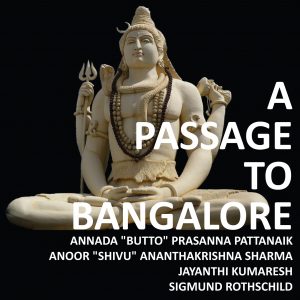 My second award was a Senior Scholar Fulbright-Nehru Teaching/Research grant to India. My first Fulbright was as a Senior Scholar to Russia, and both awards were for work in music technology. The primary project which I created in India during that Fulbright was a music CD of original compositions.
My second award was a Senior Scholar Fulbright-Nehru Teaching/Research grant to India. My first Fulbright was as a Senior Scholar to Russia, and both awards were for work in music technology. The primary project which I created in India during that Fulbright was a music CD of original compositions.
“A Passage to Bangalore” explores the use of Carnatic Tala, the rhythmic cycles of Southern India, within electronic-based world fusion music compositions. That album was created in collaboration with leading Carnatic musicians. The project’s overall objectives were to:
-
Use Carnatic tala in a CD-length work of new compositions created and recorded in India.
-
Work with Carnatic musicians.
-
Capture the collision of India’s ancient traditions with modernity.
-
Create a music CD that would be accessible, and hopefully of interest, to the general public and not just academics or music professionals.
As a working aesthetic guide, I used a “Steam Punk Asia” concept to summarize and label the project’s goals. Primarily this was a way to describe my impression of India’s culture by contrasting older sounding music technology with new tech. It was amazing to see how the region’s ancient civilization has evolved and embraces modern culture and technology.
Elements of “Steam Punk Asia” included:
-
Carnatic tala metered rhythms on drum machine.
-
Live Indian percussion, tabla & mridangam.
-
Large Hindustani bamboo flute.
-
Veena, a fretted string sitar-like instrument.
-
Synthesizer for drone & effects.
This first example from the CD, “Jayanagar,” is named after a neighborhood I stayed at in Bangalore, which is their IT capital or silicon valley. It is in an 11-beat tala cycle, called Triputa Misra. My interpretation of that tala in Western notation was a 4/8 + 2/8 + 5/8 repeated meter pattern.
Watch on YouTube: “Jayanagar”: 112.5 BPM, 4/8 + 2/8 + 5/8, Triputa Misra Tala, 11 Beat Cycle, 00:02:50.
In Southern India, the Suladi Sapta tala System is used which defines 35 possible talas or rhythmic cycles.
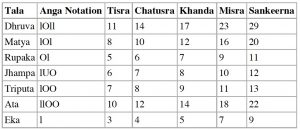 The Suladi Sapta Tala chart defines seven tala families, which are listed in the vertical column on left, starting with Dhruva. The five tala beat variations are displayed in the horizontal top row, which are called Jati, starting with Tisra. The chart’s second column depicts “Anga Notation” that uses:
The Suladi Sapta Tala chart defines seven tala families, which are listed in the vertical column on left, starting with Dhruva. The five tala beat variations are displayed in the horizontal top row, which are called Jati, starting with Tisra. The chart’s second column depicts “Anga Notation” that uses:
-
“U” = One beat, called Anudhrutam.
-
“O” = Two beats, called Dhrutam.
-
“L” = Variable number of beats, called Laghu, which depends on the number of beats in the Jati.
The Jati’s possible values are listed on the chart’s bottom row, the “Eka” tala family, which may be three, four, five, seven or nine. These Jati values are assigned to theLaghu.
The Carnatic tala are called by their family name and Jati beat variation. For example, Ata-Khanda has fourteen beats. The Anga notation shows that it is divided 5 + 5 + 2 + 2, because the Khanda Jati is five beats in length. This cycle is commonly used in Southern India, and is simply referred to as Ata tala. It is the first rhythmic pattern/metering used on the CD.
The Carnatic tala used on my project and their re-contextualization in Western notation are listed in the chart below. As a way to create a cohesive large scale composition/CD, each piece uses a tempo that is in metric modulation from the previous track.
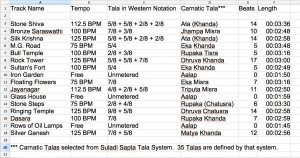
The CD’s first track, “Stone Shiva” as it appears in MOTU’s Digital Performer 7 software. Ata tala’s two bars of 5/8 and two bars of 2/8 pattern may be seen in the sequencer’s conductor and tracks windows.
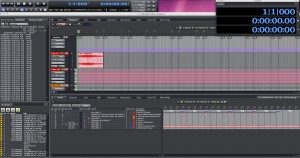
The Vierring II on Native Instrument’s REAKTOR software synthesizer design environment by Mike Daliot and Timothy Lamb was used to create the electronic percussion tracks. The Vierring II was chosen for two reasons. The Vierring allows the user to change the length of the beat grid for its individual channels. This allowed the correct lengths of the Carnatic tala cycles to be programmed. In the left column below, you will see the “Len” set to 28, which gives subdivisions of Ata Tala’s 14 beat cycle.
“Stone Shiva” programmed in Vierring II on NI’s REAKTOR Plugin
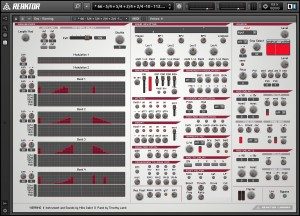
The other reason Vierring II was used is that it will take an audio signal from another sound source and use it as a basis to create percussion sounds. Under Vierring’s “Sources” section in the upper right, the instrument is set to take a signal from an external audio track. Here, Vierring took an audio loop one tala cycle in length of the drone for input and created the electronic percussion sounds. By doing this, the synth drone is spectrally related to Vierring’s percussion output.
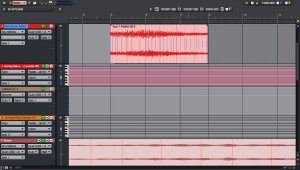
The drone is an important aspect of Indian music. Native Instrument’s SubHarmonic synthesizer from their REAKTOR library was used to create the drone, shown below. In the second picture, you can see REAKTOR’s synth building environment that includes my modifications to the SubHarmonic.
 |
 |
In “Stone Shiva” CD Track 1, you can hear Ata tala on Vierring’s electronic percussion and the spectrally related drone from the SubHarmonic synth.
Watch on YouTube: “Stone Shiva”: 112.5 BPM, 5/8 + 5/8 + 2/8 + 2/8, Ata (Khanda) Tala, 14 Beat Cycle, 00:03:32.
To tie the live percussionist’s tabla and mridangam performances to the Vierring’s electronic percussion tracks, D16 Group’s SigMund Delay Unit was used. The SigMund Delay emulates 1980s style digital delay that gave the live percussion an electronic quality which helped it blend with the electronic percussion.

“Dasara” CD Track 14, uses Rupaka Khanda, a seven beat tala cycle expressed as 7/8 in western notation. The track is named after the Mysore Dasra Festival, which is a ten-day event held annually. The festival celebrated its 400-year anniversary in 2010. Dasra is held on the grounds of Mysore Palace and throughout the city. The festival picture below depicts Hindu deities enacting the legend surrounding the victory of truth over evil for which the event is named.

This third example from the CD, Track 14 “Dasara,” captures my impressions of the festival and integrates live percussion, tabla drums, with the electronic percussion.
Watch on YouTube: “Dasara”: 100 BPM, 7/8, Rupaka Khanda tala, 7 Beat Cycle, 00:03:02.
Selecting production tools and designing workflows that integrated the use of both Carnatic tala and live Indian musicians was one of the project’s most important aspects. Making these technical and artistic choices is one of the producer’s primary roles, and I spent a great deal of time reviewing and considering the best options.
The CD Project’s Primary Production Tools and Workflow:
-
MOTU’s Digital Performer 7 rendering and recording tracks at 192kHz 32bit, ultra-high resolution.
-
NI’s Komplete Reactor synths and effects: SubHarmonic, Vierring II, SpaceMaster 2 and Flat Blaster 2.
-
MOTU’s Masterworks EQ and Compressor.
-
Balancing/pre-mastering of electronic percussion tracks across the CD. Mixes were later built bottom-up from these “locked” levels.
Recorded Indian musicians at the Aravind Studio in Bangalore on Apogee’s Duet2 analog to digital converter recording into Digital Performer 7.
-
iZotope’s RX2 used on both Flute and Veena to remove unwanted noises.
-
D16 Group’s SigMund on Percussion for delay effects.
-
IRCAM/FLUX’s SPAT for instrument localization and reverb.
-
DMG’s Equilibrium.
-
Final mixes/bounces done in MOTU’s Digital Performer 7.
-
Sample Rate Conversion (SRC) of final mixes down to 44.1kHz 16bit, CD quality, was accomplished on Magix’s Sequoia with Weiss’ Saracon conversion software at Digital Domain by Bob Katz.
-
Millennia Music & Media’s POW-r 2 Dither was used.
-
Disk Description Protocol (DDP) file was created on Sonic (Solution) Studio/Sound Blade.
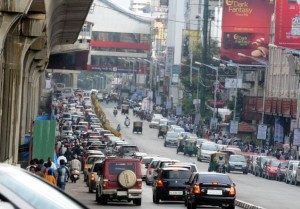 This last example from the CD, Track 4 “M.G. Road” captures my impressions of the heart of Bangalore. “M.G. Road” best reflects the project’s goals, was the most characteristic “Steam Punk Asia” piece on the CD, and as with all the pieces, used the tools and production methodology outlined above. “M.G. Road” used Eka Khanda tala, which in Western notation was interpreted as 5/4.
This last example from the CD, Track 4 “M.G. Road” captures my impressions of the heart of Bangalore. “M.G. Road” best reflects the project’s goals, was the most characteristic “Steam Punk Asia” piece on the CD, and as with all the pieces, used the tools and production methodology outlined above. “M.G. Road” used Eka Khanda tala, which in Western notation was interpreted as 5/4.
In the picture of M.G. Road, you can see the new commuter train platform on the left, auto rickshaws,and even a Kentucky Fried Chicken if you look closely on the right side. Southern Indian food is extremely spicy, and without KFC and a few other American food franchises, my nine months stay in India may have become unmanageable.
Watch on YouTube: “M.G. Road”: 75 BPM, 5/4, Eka Khanda tala, 5 Beat Cycle, 00:03:40.

Annada “Butto” Prasanna Pattanaik performed on the large Hindustani bamboo flute for the CD. Butto has played on over 800 Indian film soundtracks and has given concerts all over the world.
To record the bamboo flute we used Aravind Studio’s AKG C1000. This microphone had obviously been used for many years, and gave the flute that authentic, old tech, recorded in India, “Steam Punk Asia” sound which I wanted for the project. This heavily saturated flute sound tied nicely to the drum machine and live Indian percussion. Very little other processing was used on the flute. Although much time was spent experimenting with different EQs, the final mixes used only a slight +2dB increase at 5kHz and high pass filtering. IRCAM/FLUX’s SPAT was used to localize the flute in the stereo field, and to add the larger reverb space. The SpaceMaster 2 was used to add complexity and immediacy to the flute sound.
 |
 |
 |
Dr. Jayanthi Kumaresh played Veena, India’s national instrument, for the CD. Through her many awards and recordings, Dr. Kumaresh is recognized as one of India’s leading Veena players, and is the Indian National Orchestra’s Music Director. She has performed with many renowned artists on stages around the globe.
 |
 |
As can be seen in the picture above, the Veena was recorded with both a Neumann KM- 184 microphone and pickups/DI. Again, IRCAM/FLUX’s SPAT was used for localization and depth with the SpaceMaster 2 adding immediacy.

Anoor “Shivu” Ananthakrishna Sharma performed the live Indian percussion, tabla and mridangam, for the CD. Shivu was born in Bangalore, has performed and recorded with many internationally renowned artists, toured extensively in Europe and the US, and is the Music Director for the Percussive Arts Centre’s Large Percussion Ensemble. While I attended many concerts in India, the video below which I took is one of my favorites. That concert was highly influential while developing this CD.
Watch on YouTube: Shivu, center stage, leading the Laya Vrushti Percussion Ensemble.
The live Indian percussion set-up was different for each CD track, so each piece has different EQ and effects processing. NI’s Flat Blaster 2 in their REAKTOR was used on all the percussion tracks for amplitude limiting.
 |
 |
The opportunity to collaborate with leading Carnatic musicians, learn about Southern Indian culture and Carnatic music, and disseminate music based upon those explorations was a life-altering experience. The Fulbright Program’s mission is to “increase mutual understanding between the people of the United States and the people of other countries.” Hopefully listeners will hear that mission in this project.
The Fulbright Program is administered by the United States Department of State’s Bureau of Educational and Cultural Affairs. Application information may be found at: http://eca.state.gov/fulbright.
“A Passage to Bangalore” is available on iTunes and Amazon.com.